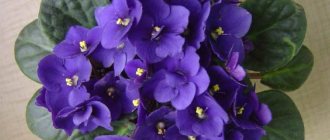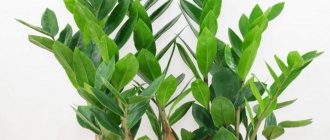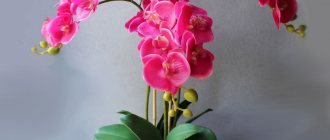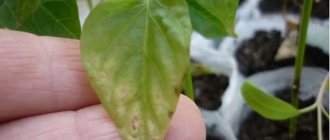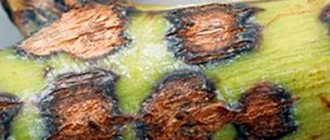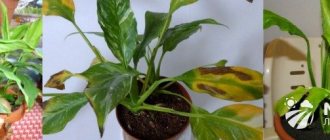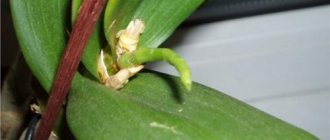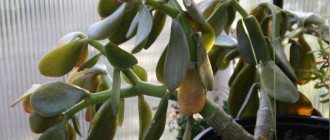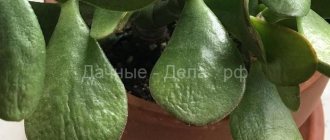Zamioculcas, or as it is popularly called the “dollar tree,” is a beautiful decorative foliage indoor plant. It is valued precisely for the beauty of its foliage, which, with proper care, can grow more than a meter in height. But sometimes the leaves of the dollar tree begin to turn yellow, dry out and fall off. This happens for various reasons, most often from improper care. Let's consider what to do if the leaves of zamioculcas turn yellow, and what contributes to the development of this disease.
1. The structure of Zamioculcas 2. Causes of yellowing of the leaf blades of the dollar tree 2.1 Improper care of the plant 2.2 The appearance of pests 2.3 Diseases and natural causes of yellowing of leaves 2.4 Yellowing of leaves after transplanting Zamioculcas 3. Causes of yellowing of the tips of leaves and stems of Zamioculcas
Photo by O. Nikonorova: Zamioculcas is an ornamental deciduous indoor plant, the leaves of which can turn yellow and dry out if not properly cared for.
Directory of indoor plants
The trunk of the zamioculcas became soft and wrinkled.
Read in today's article, why does the Zamioculcas trunk wrinkle, the leaves fade, and spots appear? We'll tell you what to do to restore zamioculcas. Why does the Zamioculcas trunk shrink?
The shriveled stem and leaves of Zamioculcas do not appear spontaneously - the degradation of the plant is preceded by other visible symptoms, for example, falling leaves, yellowing, and wilting of the plant. We have looked at why the leaves of Zamioculcas turn yellow and dry
What flower growers say:
- The trunk of Zamioculcas shrivels if it is too dry.
- Wrinkled leaves and trunk, softened shoots - flooded, roots rotted.
- The leaves wrinkled - there was little light.
Violations in the regime and volume of watering remain the No. 1 reason why Zamioculcas has a problem with leaves. In this case, the plant can be either yellow or wrinkled - depending on whether it has been dried out or waterlogged. In order not to wait for the leaves to fall, you need to restore moisture.
Dry air and dry soil
Severe drying out of the soil can also negatively affect the appearance of the plant. If a lump of earth regularly dries out, it lacks moisture. In this case, its leaves begin to turn yellow, and some of the roots die. How to revive zamioculcas - you need to increase watering. To restore the root system, you can use special rooting preparations.
Yellowing can also be caused by very dry air and high temperatures in the apartment. In the summer heat, to prevent the leaves from turning yellow and drying out, you need to humidify the air in the room where the zamioculcas is located. Spraying with water or wiping the leaves with a damp sponge gives good results.
How to save Zamioculcas?
- Drenched zamioculcas - dry . Stop watering until the earthen ball is completely dry. Start adding water little by little, taking your time to moisten or increase the moisture concentration. Monitor the condition of zamioculcas.
- Overdried zamioculcas - gradually moisten . Wrinkled from lack of moisture, if there really is any, the leaves of Zamioculcas will return to normal as soon as water arrives. It is important not to flood the tuber with root shoots at once. In addition, be sure to use settled, warm water; Do not direct the stream of water at the root collar.
Zamioculcas with a rotten tuber cannot be saved due to temperature fluctuations, violations of the same watering regime, or direct and concentrated fertilizers. It is necessary to remove the zamioculcas from the ground, inspect the roots and, if there is something to save, replant it in fresh soil after pruning and processing. In detail: how to save zamioculcas if the tuber has rotted?
What you need to trim the roots: pruning shears, powdered charcoal or Fundazol, as well as fresh soil soaked with a 1% solution of potassium permanganate. How to transplant zamioculcas correctly?
Adjust the lighting - bring Zamioculcas back to life
Lack of sunlight has a bad effect on zamioculcas - the leaves wrinkle due to short-term, poor lighting. Direct rays are also not the best helpers in caring for zamioculcas.
How to properly highlight zamioculcas:
- Increase lighting if it was shaded.
- Do not place in direct light.
- Heat is not lighting.
- Place it on the southeast, southwest window.
Where does Zamioculcas usually stand? In the corner on the floor, near the sofa or bedside table. The place was chosen for the grower, but not Zamioculcas. In such a place, the plant gets sick, catches a cold, and suffers from lack of light. It is correct to place Zamioculcas at home on a stand or high bedside table, close to the window, or in a well-lit area.
Every time before changing the procedural regime, carefully look at the plant: what is missing, what it looks like, what is better to add to the soil or, conversely, what to exclude from the care schedule. The plant is alive, does not rely on calendar moisture or fertilizing, and its development vector changes depending on the microclimate and season. Zamioculcas: signs and superstitions . Listen to your zamioculcas and it will tell you why the trunk is wrinkled , and with the help of our recommendations you can quickly match the problem with the solution.
↓ Write in the comments why the trunk of your zamioculcas is wrinkled? What helped the plant?
Please rate the material you read :)
What to do?
If yellow leaves appear on zamioculcas, it is necessary to urgently take measures to eliminate the causes that provoked the appearance of this problem. Ignoring this situation may lead to the death of the flower. In case of excessive watering and rotting of the tuber, a number of measures must be taken:
- removing a plant from a flower pot;
- visual inspection of the root system;
- removing all rotten, soft and decayed areas using a sharp instrument;
- disinfection of the cut surface using medical brilliant green or crushed activated carbon;
- drying the treated onion at room temperature in a ventilated area;
- transplanting the flower into a new planting container with nutrient soil.
If a change in the color scheme of the leaves occurs as a result of a natural process provoked by the growth and development of the plant, it means that the flower receives the maximum amount of attention without any disruption in care techniques. If a flower dries out from lack of moisture, you must urgently begin to moisten the soil in small portions several times in a row. Only after the water balance has been restored can you move on to the correct watering regime. It is strictly forbidden to immediately pour a large amount of water into dry soil, the excess of which will provoke the development of putrefactive processes. If drought has led to the complete drying out of the entire above-ground part, experienced gardeners do not recommend throwing away the plant, but trying to revive it with proper watering.
At the first sign of the appearance of dangerous pests, the following set of measures must be taken:
- making a soap composition from laundry or tar soap mixed with water;
- densely covering the soil with paper, food foil or a plastic bag;
- removing pests and larvae using a soap solution and a soft sponge;
- rinsing the foliage with clean water at room temperature.
Some gardeners prefer to treat the plant with chemicals that are designed to kill a specific pest. In order not to harm the flower, it is necessary to use insecticides in strict accordance with the manufacturer's recommendations. If the leaf blade has been damaged due to exposure to sunlight or low temperatures, the plant must be moved to more comfortable conditions and restorative preparations applied to the leaves.
To obtain a healthy plant, it is necessary to regularly add nutrients to the soil. Uncontrolled use of chemical nitrogen fertilizers can cause leaf discoloration. Experts advise giving preference to organic products.
In case of fungal and bacterial diseases, it is necessary to place the flower pot in a dry room with good ventilation and stop watering, remove the plant from the pot and cut off all affected parts. Treat the resulting sections with disinfectants and plant the flower in a new pot.
Experienced gardeners recommend paying special attention to the rules of transplantation
If you carelessly move the flower to a new container, mechanical damage to the bulb may occur, but the flower can still be saved. The deformed plant must be removed from the pot, the rotten areas must be cut off and allowed to dry.
The deformed plant must be removed from the pot, the rotten areas must be cut off and allowed to dry.
Why do zamioculcas stems go down and what to do in this case?
Hello, dear readers of my blog! This guest from Tropical Africa flaunts on the windowsills of many residents of the middle zone, delighting with its lush greenery. However, despite its unpretentiousness, failure to comply with certain conditions of detention is fraught with the appearance of various problems. Today I want to figure out with you why the stems of Zamioculcas droop?
What is this connected with?
The plant's homeland is hot Africa, so everything must be done to make the flower feel at home. How are things at home? The sun burns mercilessly, and beneficial rains irrigate the land only from time to time. Therefore, you need to water it abundantly, but rarely, waiting until the earthen clod is completely dry and providing access to light. Although I know owners whose zamioculcas feels great on the shady side, it’s still better not to tempt fate and place the pot with the plant where there is enough light.
If you notice that the stems of your dollar tree have begun to droop, the main reasons may be:
- Insufficient lighting. Often our compatriots buy indoor flowers to decorate the interior, placing pots on the floor near sofas and other pieces of furniture. If the wall opposite is not made of glass, then the flower will be dark and it will begin to wither.
- Failure to comply with temperature and humidity conditions. The flower tolerates air temperatures up to +30 ᵒС and above perfectly, but its decrease is undesirable. And if you consider that in the summer we escape the heat with the help of air conditioners, then it is quite natural that the plant does not like it. Make sure that the air in the room does not cool below +18 ᵒC and do not try to moisten it too much by spraying around the flower.
- Overwatering. Are the stems turning black and shriveling? Most likely you flooded Zamioculcas. This is very dangerous, as the roots may rot and it will be more difficult to save the plant. Remove it from the pot and inspect it for rotten roots. If there are any, remove them, treat the cut areas with charcoal, and in more severe cases, you can use “foundazol” or “epin”. Dry the tuber for 2 hours, and then transplant it into a new substrate and do not touch it for a day or two. Then start watering little by little.
What to do if you don’t water the plant often, but the soil doesn’t have time to dry out and even becomes covered with mold on the surface? Firstly, the soil must be suitable for such a lover of arid climates. Add more sand to it, or even better, buy a special one for succulents. Secondly, the pot itself must be breathable, so plastic containers are not suitable for this. There is nothing better than clay ones yet. In such a pot you won’t even notice how quickly the soil dries out - I checked it for myself. And mold will never appear. Don't forget about the thick layer of drainage at the bottom of the pot.
To please you with beauty and health
In order for the plant to be beautiful and healthy, you should not neglect the very simple rules for keeping zamioculcas.
A healthy plant evokes only positive emotions
Shoot growth problems
To make Zamioculcas grow greenery faster, do not plant it in a spacious pot. The larger the container of the flower, the larger the root tuber and the more modest the leaves. The soil for this semi-succulent plant needs to be porous and poor. Suitable soil for cacti or universal soil, heavily diluted with coarse sand. Vermiculite, perlite and sphagnum moss are not to the liking of this flower, Zamioculcas experts say. But he will appreciate high-quality drainage: holes in the pot and a layer of expanded clay at the bottom.
Zamioculcas tubers store moisture and nutrition in case of drought
Be careful with water: overfilling is worse than underfilling
In the summer, please your zamioculcas with a holiday in the fresh air, put it on the balcony or in the garden. The African feels great on a hot afternoon in the sun. There is no need to specially humidify the air for it. Of the water procedures to help the flower breathe, leave only wiping the foliage from dust and occasionally a warm shower. When bathing, be sure to cover the soil with waterproof material to avoid over-wetting it. It is important not to be too zealous with watering; Zamioculcas will even be happy if you sometimes forget to give it water. Wait until the soil is completely dry, wait another 3-4 days and only then water. But know the limits with moderation: with prolonged drought, the leaves will begin to fall. True, it’s not difficult to correct the situation: if the root is alive, just add water.
It is convenient to check whether watering is needed using a thin wooden skewer. It must be carefully inserted at the edge of the pot to the very bottom, then turned around its axis and pulled out. If wet soil sticks to the skewer, it is too early to water.
Zamioculcas is afraid of waterlogged soil
But overmoistening the soil is a sure path to serious problems and diseases: especially severe when excess moisture is combined with low temperature and lack of lighting. This combination can destroy the main part of the plant - the root, not to mention the yellowing and blackening branches.
Table: they prevent growth and development - diseases and pests
| Diseases | Pests |
| Root rot (tuber) | Spider mite |
| Stem rot | Aphid |
| Chlorosis | Mealybug |
| Fomoz | Shchitovka |
| Spotting | Fungus gnat (midge) |
| Black | Podura |
For healthy stems and roots - disease prevention
Very often, flower growers say that they cared for zamioculcas according to the rules, but the plant still got sick or was attacked by pests. The reason is the lack of reasonable prevention. Pathogens or parasites can get into a flower pot if safety precautions are not followed. There is phytosanitary control at state borders. It should be at the entrance to every apartment.
To keep your plants healthy, follow the rules of care and replanting.
How to ensure plant safety:
- carry out “entry control”. When you bring home a new plant, whether from the store or somewhere else, make sure it is not infected with disease or parasites. Inspect the stems, and, if possible, the roots, for visible symptoms: spots, dots, and other damage. Inspect your zamioculcas for insect pests. A barely noticeable white spot may be a mealybug, and a brown one may be a scale insect. It is better to discard a plant with signs of disease. Such an acquisition will bring more trouble than pleasure;
- quarantine is mandatory for beginners! In your opinion, the plant is perfectly healthy - don't trust first impressions. Problems may appear after some time. Don't place the newbie right next to the other colors. Keep him in isolation for two weeks, or better yet, a month. And only after quarantine introduce the new plant to your windowsill neighbors;
- sterility is the key to health. Be careful when replanting Zamioculcas. Most bacteria, fungi and parasites spread through soil. Before planting, disinfect the substrate (including store-bought) by calcining it, frying it in the microwave, and pour boiling water over the pot. You can also water the new soil with a solution of Fitosporin (other fungicides) or manganese, then dry it.
Video: How to Grow a Healthy Dollar Tree
Why did Zamioculcas get sick, and how to help your favorite plant
Zamioculcas needs quite competent care Zamiocúlcas, the celibate flower or dollar tree, belongs to a monotypic genus of plants from the Araceae family. The plant’s homeland is tropical Africa, and when cultivated in our country, flower growers may encounter problems such as zamioculcas drying out and not producing new shoots or not growing and slowly dying. That is why, when growing ornamental crops, it is very important to do timely disease prevention, as well as to follow agricultural practices.
Botanical characteristics
The herbaceous plant has a thick, tuberous rhizome and glossy, dark green, pinnate foliage. The average leaf length reaches a meter. The leaves have swelling at the base. Less than ten years ago, breeders obtained a miniature cultivar of the plant, represented by a compact bush no more than 0.6 m high, with small foliage.
Zamioculcas are unpretentious plants and can easily tolerate low air humidity levels, as well as partial shading. However, for full growth and development, the plant needs bright rooms and the absence of direct sunlight. Decorative crops do not respond well to excessive soil moisture and stagnant moisture, so irrigation measures must be strictly regulated. If a houseplant is heavily flooded, it means that it will not be possible to easily save the ornamental plant, and a whole range of restoration measures will be necessary.
Zamioculcas are unpretentious plants and can easily tolerate low air humidity levels.
Zamioculcas does not have any special requirements for the soil composition, so the indoor plant grows well in self-made soil based on turf, leaf soil and medium-grained sand, which are mixed in a 1:1:1 ratio. The crop can be propagated by dividing the tuber, as well as by rooting a leaf or a separate leaf blade.
Zamioculcas inflorescences are inconspicuous and not very decorative; they are light cream spadixes formed on short and thick peduncles. The inflorescence is surrounded by a light green blanket. In home floriculture, zamioculcas bloom extremely rarely. It should be noted that the plant is poisonous, therefore, when replanting and pruning or forming branches, as well as dividing tubers, increased precautions must be taken using rubber gloves.
How to save Zamioculcas (video)
Doesn't give rise to new shoots
The main vital organ of any plant is the root system, which in Zamioculcas includes a large tuber and the roots themselves growing from its apical part. At the first stage, the plant masters the volume and fills the flower pot, after which the moisture-storing tuber grows. During this period, there is no development of the aboveground part of the plant.
Among other things, Zamioculcas is a southern plant, so the activation of growth processes, accompanied by the formation of new shoots or stems, begins quite late and continues until the last ten days of winter. The formation of shoots is observed in the so-called reserve buds, and the density of an adult ornamental bush is directly proportional not only to the size, but also to the number of tubers.
Zamioculcas ill health manifests itself in the appearance of yellow spots
The plant dries up
When growing zamioculcas, it is very important to take into account the biological characteristics of this southern ornamental crop, since otherwise the plant gets sick, and the ill health of zamioculcas is manifested in the appearance of yellow spots, drying of the tips of the leaf blades, and loss of elasticity of the stem part. Failure to comply with agricultural practices causes yellowing, reduction of leaf lobes and blanching. Such problems threaten not only the complete loss of decorativeness, but also the death of the plant.
Sometimes dark spots appear on the above-ground parts of the plant. The reasons for this phenomenon may be represented by too wide a range of temperature indicators in the growing room, the negative impact of drafts and abundant watering of zamioculcas. To rid plants of spots on the foliage, it is necessary to completely eliminate the presence of negative and traumatic factors for the ornamental plant, including changes in the irrigation regime and temperature changes. It is important to remember that the appearance of dark spots on the foliage may also indicate damage to the ornamental crop by plant parasites.
Zamioculcas: cultivation (video)
Why is an indoor flower crying?
All amateur flower growers involved in growing zamioculcas in indoor floriculture are very well aware of such an interesting phenomenon as the crying of a decorative flower, which is accompanied by the appearance of drops of moisture at the tips of the foliage, truly reminiscent of tears. The indoor ornamental plant cries when treated poorly, including damaged leaves, overfertilization, and excessive irrigation.
Other diseases
Many diseases of ornamental crops are the result of improper care. Excessive watering can reduce the supply of oxygen and reduce soil drainage, which makes adequate nutrition of the root system of an ornamental crop impossible. The roots begin to rot, and nutrients do not reach the plant, which causes weakening of the stems. Thin and exhausted stems quickly droop. Also, thin trunks of Zamioculcas grow in insufficient light. There are situations when the trunk disappears, but the plant can still be saved and, as a result of following agricultural practices, new shoots appear from the underground part.
Zamioculcas cries when treated poorly, including injured leaves, overfertilization, and excessive irrigation.
Diseases: treatment and prevention
The most common cause of Zamioculcas malaise is waterlogging of the soil. Because of this, the plant is affected by various types of rot. But there are also diseases associated with mechanical injuries and metabolism. They weaken the immune system. And as a result, the same rot appears.
This zamioculcas needs diagnosis and urgent treatment
Injuries are the cause of many problems
Zamioculcas injuries: a broken branch, frostbite, scratches and tears are not terrible in themselves, but can lead to serious illnesses, becoming a gateway to infections. If the wounds are not treated, the plant may become infected. Be sure to disinfect the injured area. You can sprinkle with activated carbon, sulfur powder, cinnamon (it is a good antiseptic), grease with brilliant green and dry. As the wound heals, it will become covered with a layer of dry, dead cells and then heal.
If you accidentally break off a healthy Zamioculcas leaf, you can root it. Cut it off above the break point and place it in water. Soon roots with a small tuber will form. After this, plant the plant in a small pot with light soil.
You can grow a new plant from an accidentally broken Zamioculcas leaf
Metabolic diseases
These diseases are not infectious, but associated with care errors. The most common are chlorosis, etiolation (light deficiency), deficiency or excess of macro- and microelements.
- chlorosis is a disruption of the process of photosynthesis. Zamioculcas leaves become discolored, turn yellow, and white spots appear on them. Treat the plant with Fitoverm several times at intervals of 3–4 days. Feed him. For prevention, spraying with iron chelate (Antichlorosin) can be used. Some gardeners advise burying a rusty nail in the ground to provide it with iron;
- etiolation is a disease caused by light deficiency. Zamioculcas prefers bright light, but also tolerates shade. This patience should not be abused. If the plant does not have enough light, the leaves stretch out unsightly, become discolored, and the leaf segments become smaller and smaller. Place the zamioculcas on the sunny side, and in winter, arrange artificial lighting for it.
This zamioculcas does not experience light deficiency, which means it is not threatened by etiolation
Table: effect of nutrient deficiency on plant appearance
| External manifestation | Problem |
| Inhibition of leaf growth | Not enough nitrogen |
| Growth slows down, the plant turns pale | Fluoride deficiency |
| The root system develops poorly | Low calcium |
| Development has stopped | Possibly copper, boron, chlorine or iodine are deficient |
Mineral feeding will solve the problem of lack of nutrients. Select a complex for the plant that will contain deficient elements. Typically, Zamioculcas is suitable for fertilizers for cacti and succulents.
When rot appears
The Zamioculcas tuber, its thick petioles, is a storehouse for nutrients and moisture. In such a favorable environment, harmful microorganisms happily multiply: fungi, bacteria and viruses. Zamioculcas tuber is a tasty food and convenient shelter for them. Sometimes the florist himself, due to inexperience, helps uninvited guests settle in a pot with a plant. Overmoistening of the soil and air, especially in winter, non-compliance with temperature conditions, contaminated soil - all this contributes to the spread of various types of rot, the most dangerous diseases of zamioculcas.
A healthy plant has green leaves and light brown elastic tubers.
Table: types of rot, methods of control, prevention
| Type of rot | Symptoms | Treatment | Prevention |
| Dry rot, or fomoz. Kovarna asymptomatic | At first the plant turns slightly pale, then dries out from the inside. The disease is fleeting. | The disease is discovered too late, when it is already useless to take any measures. A plant infected with dry rot inevitably dies. | To prevent phomosis, periodically spray or water zamioculcas with a solution of systemic fungicides, for example, Maxim. |
| Rot of stems (leaves) is caused by heavy clay soil that does not provide air and water permeability, excessive watering at low temperatures, injuries, and the disease is caused by an attached bacterial infection. | A damp brown coating appears on the petioles of Zamioculcas, the tissues soften and die | This is the most common cause of death of a flower; you can try to save it by digging up the tuber and removing the affected parts, sprinkling the cuts with crushed coal. The entire plant, both above-ground and underground parts, is treated with a systemic fungicide (Oxychom, Fundazol) and planted in a new pot, completely replacing the substrate. If the process has gone too far, the affected tuber is thrown away, the remaining parts of the leaves are used for propagation | Heal all injuries on the plant, follow the care regimen, be sure to quarantine new acquisitions |
| Root rot (tuber) occurs at low temperatures, systematic waterlogging of the soil and stagnation of water | Zamioculcas affected by root rot, if no action is taken, turns yellow, withers and dies. The cause of the disease can only be seen by removing the plant from the pot. | If the rot has affected a small part of the tuber:
If the putrefactive process has affected almost the entire tuber, you will have to throw it away and try to root healthy leaves | Follow the main rule of watering zamioculcas: moderation and moderation again. Maintain normal temperature |
Zamioculcas - dollar tree
The popular name for Zamioculcas is dollar tree, I only recently learned about it. Last year I chose a flower for a friend’s birthday. I tried to take into account the features of her apartment.
The seller advised me to take a dollar tree. I was confused and asked to clarify what it was, they showed me Zamioculcas. This plant had been in the store for several months, and since it was January, this fact played a decisive role (it was a cold winter and the flowers could have been damaged during transportation).
At home I noticed that the Zamioculcas seemed to be “jumping” out of the pot. The seller advised to replant it. I chose a slightly larger pot. When transplanted, the plant split into several pieces. As a result, one part remained with me. Later I regretted that I started the transplant during the cold period.
The plant that I gave to a friend was partially lost - some sections rotted. After some time, the remaining part of mine also rotted. So much for dubious guarantees - staying in the store for several months. Everything was decided by an untimely transplant.
Almost a year has passed. I recently noticed that my friend now has two dollar trees. The second one was given to her as a shoot. It was summer, and it took root well.
Zamioculcas belongs to the aroid family - these are the well-known Dieffenbachia, Philodendron, Monstera, etc. Over the past ten years, Zamioculcas has become widespread among gardeners.
It ceased to be exotic and, accordingly, began to be in less demand. There is no chic or beauty in his appearance, so I always put off the purchase until later. And after I bought it as a gift, I completely lost interest.
But a friend gave me a leaf from Zamioculcas (she accidentally broke it). The leaf was at least 30 cm, with a thick petiole and succulent leaves. I cut off the top, separated several lower leaves, and began to root. I placed a large leaf in a vase with slightly damp vermiculite.
The remaining parts were also rooted in vermiculite, but in a closed container. All parts took root in about a month and a half. But the smaller ones - the top of the leaf and leaves quickly fell into a period of dormancy, i.e. their leaves have turned yellow. I found several nodules 1 cm in diameter in vermiculite. The larger leaf took longer to take root.
I planted it in a tall, narrow pot with good drainage. It was a warm period. Rarely watered. I also planted the nodules, but in a small pot. They never sprouted.
The large leaf did not grow at all in the first year. He stood and stood. Then something strange appeared at the base. It even seemed to me that it was a bud, but a leaf appeared, only small in size. Its leaves were also small. During the spring-summer period, Zamioculcas produced three more large leaves, but the first one remained juvenile.
Zamioculcas stood on the kitchen window. I did not suffer from the heat. Closer to winter, I had to move it to the other, darker side of the window sill. This immediately affected the color of the new leaf - it grew light green.
I don't know if the color will change in the summer. I noticed that in many institutions zamioculcas are placed quite far from the windows, as a result they stretch out and the “bush” falls apart.
The summer was hot, so I did not fertilize. Only occasionally did I add Baikal-EM1 to the irrigation water. Watered only when the top layer of soil was completely dry. In winter I adhere to the same theory.
Streptocarpus. Care, propagation Compared to Saintpaulias and Gloxinias, other representatives of the Gesneriaceae family are not so universally known, although among them there are no less charming plants, for example, Streptocarpus and Achimenes.
Causes of yellowing leaves
Zamioculcas is a prominent representative of African plants, which was brought to the territory of European countries. The plant belongs to the cactus family. The peculiarity of the flower is the absence of branches and stems. The aboveground part of the plant is presented in the form of complex and fleshy leaves of a dark green color. The appearance of the flower provoked the appearance of a second name - dollar tree. Novice gardeners often have no idea that the dollar tree is a succulent and requires special care.
Biologists identify the most common reasons why a flower's leaves turn yellow.
- Frequent and abundant soil moisture is the main cause of yellowing of foliage, which directly depends on the structure of the root system. The root system of a flower is presented in the form of a tuber, the task of which is to accumulate nutrients and gradually enrich the stems with them. Inexperienced flower growers water the African flower when the soil dries out, forgetting that the bulb has already absorbed moisture and must use it up. Frequently moistening the soil mixture will lead to excessive accumulation of liquid and rotting of the root system. The immune system of Zamioculcas will begin to spend all its energy on restoring the bulb, taking vital energy from the leaves, which will certainly begin to turn yellow and fall off. Signs of soil overmoistening are yellowing of leaf lobes and the appearance of dark wet spots.
- Natural aging is an irreversible process due to which old leaves wither and new ones form. A feature of the dollar tree is the formation of no more than 17 leaf blades on one cutting. As the plant grows, the petioles lengthen and old leaves are naturally replaced with new ones. There is no leaf cover in the root zone of an adult zamioculcus. Signs of natural aging are the formation of new petioles and occasional yellowing of the lower leaf blades.
- Insufficient watering is a common reason, provoked by the understanding that Zamioculcas is a cactus and does not need regular soil moisture. A plant in artificially created extreme conditions starts the process of economical consumption of moisture. For the full growth and development of all leaves, the flower simply does not have enough water.
- The presence of dangerous pests is a common problem that can lead to the death of a flower. The most dangerous insects are aphids, scale insects and mites. The appearance of yellow dots, spots, holes and spider hairs on the leaf blades is a clear signal that indicates the presence of pests.
- Sunburn and frostbite are a problem that can arise due to direct sunlight on the plant or under the influence of low temperatures. Ultraviolet radiation and frost negatively affect the African plant. Signs are the appearance of yellow spots of irregular shape on the leaf blade, which tend to increase.
- Uncontrolled application of nitrogen fertilizers is the main mistake of novice gardeners. Biologists recommend replacing chemical fertilizers with organic preparations, the elements of which are better absorbed.
- Fungal disease is a dangerous problem that can lead to the death of your dollar tree. The most dangerous diseases of Zamioculcas are fusarium, late blight, and anthracnose. Signs are a slowdown or complete stop of growth, the appearance of brown spots on the bulb, wilting of the foliage and a change in its structure and color.
- Bacterial diseases are problems that arise due to the penetration of pathogens into plant tissue. High humidity and air temperature, as well as watering with cold water, can trigger the development of bacterial diseases. The most common diseases are wet and dry rot. Signs of wet rot are the appearance of dark gray, black and brown spots.
- Damage to the root system during transplantation is a common problem for novice gardeners, caused by non-compliance with transplantation rules and mechanical damage to the surface of the tuber. If the plant does not develop and the branches dry out, immediate measures must be taken immediately.
- The presence of a large number of leaves on a small tuber is a common problem that arises after dividing the bush. The condition of the plant will stabilize on its own after strengthening the root system.
Zamioculcas | Zamioculcas (Dollar Tree) – Planter Zone
Family Araceae. Homeland o. Madagascar. Zamiakulkas is an evergreen tuberous plant with dark green, fleshy leaves that are pointed at the end. The surface of the sheet is glossy. The stems are thick, the leaves sit on them symmetrically, alternately. The plant is large, grows in an apartment to a height of about 1-1.5 meters. It blooms in indoor conditions, if it is provided with appropriate conditions for keeping white flowers, but at a fairly old age. Undemanding in culture.
Temperature: Moderate, preferably 16-18 °C in winter, but not lower than 12 °C.
Lighting: A bright place with diffused light. In summer, he prefers to sit outdoors - on the balcony, in the garden, etc. In winter, you will have to move the zamioculcas closer to the window.
Watering: Moderate from spring to autumn, but no water should remain on the tray; watering is rare in winter; the soil should dry well before the next watering. Zamioculcas tolerates some dryness more easily than stagnant water in the soil - this can lead to rotting of the roots and the formation of stem rot.
Fertilizer: From April to August, fertilizing is carried out every two weeks, since Zamioculcas quickly consumes nutrients. You can use fertilizers for cacti and succulents.
Air humidity: Zamioculcas does not require spraying the leaves, but sometimes it is necessary to wash them so that the plant does not become dusty and does not lose its attractiveness. In summer, outdoor rainfall is sufficient.
Caring for Zamioculcas at home
Zamioculcas has been cultivated in our country relatively recently as a houseplant. This plant is very suitable for our apartments, where central heating creates dry air in the apartments close to deserts. In addition, the indoor plant Zamioculcas is very unpretentious. You can forget to water it, it tolerates bright sun and slight shading well, a fairly wide temperature range (from +12 °C degrees in winter, to +30 °C and above in summer). Zamioculcas does not need to be sprayed, although spraying does not cause any harm to Zamioculcas.
The answer to the question: “How to care for Zamioculcas?” simple - zamioculcas loves warmth, bright light, and very moderate watering. It does not like dampness, especially at low temperatures, so zamioculcas should be watered in the summer as the earthen clod dries completely, and in the winter no more than 1-2 times a month.
The best place in an apartment for Zamioculcas is the window sill of a south window, but it will not wither away on the north side either. True, with this arrangement, the leaves of the plant will be somewhat smaller, and in this case it should be watered much less often. In summer, it is good to take the Zamioculcas flower out onto the balcony.
The dollar tree also has no special requirements for soil. The soil in the pot can be anything except clay (you can use a ready-made soil mixture for cacti), but good drainage is required.
Zamioculcas grows slowly, so there is no need to replant it often, but still, when the entire space of the pot is filled with roots, replanting into a larger volume is very desirable for zamioculcas. When replanting, pay attention - the tubers do not need to be deepened into the ground. They should be slightly visible on the surface.
You need to feed zamiakulkas with fertilizers for cacti and succulents very carefully, only once a month during the growing season, and even then it is not necessary. It is better not to feed at all than to overfeed. During the dormant period in winter there is no need to feed at all.
Zamioculcas turned yellow:
When the leaves turn yellow, does the plant still produce young shoots? This means everything is fine. This is a natural biological process of renewal. Young leaves, being more active, take all the necessary nutrients from the soil, leaving almost nothing for more mature leaves. In this case, you should pay attention to the presence of dark spots on the leaves. Dry spots are no reason to worry; the plant is fine. It does not require any additional care or external intervention. But frequent and abundant watering can lead to yellowing of the plant. Reducing the volume of fluid may not always be a solution to the problem. Often you have to take the plant out of the pot to examine it for rotting areas of the root system. They are removed by sprinkling the cut areas with crushed coal, treated with special substances that prevent the development of rot, and transplanted into a new substrate.
Zamioculcas tolerates changes in temperature in the room very poorly.
The plant may react to this by turning yellow and falling leaves. Indoor species are more heat-loving plants than their wild relatives. They can react to absolutely any vibrations, be it a breath of wind from an open window, a running fan or any heating device. In winter, when the indoor temperature rises, it is recommended to humidify the air.
Spots appear on leaves and twigs
If spots appear on the leaves of zamioculcas, this indicates a violation of the watering regime, namely an excess of moisture, and also indicates that the temperature is unsuitable. In order for the dark spots on the leaves to disappear, it is necessary to increase the temperature in the room and remove the bush from a draft. In addition, it is necessary to reduce soil moisture, make holes in the pot to drain excess water, and pour drainage material into the bottom of the pot. Sometimes replanting the plant into a new pot helps get rid of dark spots. There are several other reasons why Zamioculcas becomes spotted. Dark spots can appear not only on the leaves, but also on the stem due to pests. One of the most common pests is scale insects. It must be combated with a solution of fungicides. In addition, dark spots on the stem can occur due to sunburn. Although Zamioculcas is a light-loving plant, it should not be in the sun after spraying. Droplets of water, being on the stem and leaves, enhance the light and act like small lenses, which is why small dark spots appear.
Zamioculcas what to do if the tuber has rotted:
The reason for this condition is, again, excessive watering of the plant. He urgently needs to be transplanted. Soil for replanting must be purchased at a specialized store; ordinary soil from the street will not help restore the plant. Such store-bought substrates are rich in all the microelements necessary for the rapid recovery of the plant. A sharp knife will help cut off all the rotten elements of the rhizome; the remaining healthy part in the cut areas is treated with special solutions. Only after this the plant is ready for transplantation. The zamioculcas should stand in peace and quiet for a day after transplantation. No fertilizers or other means are allowed. After time has passed, you can begin to water carefully. Organic fertilizers will be useful in a week; you must continue to apply them for 1 month, no more than once a week.
Pests that cause disease
Many gardeners are concerned that Zamioculkas leaves are beginning to change color. On the dollar tree, as on any indoor plant, if the rules of care are not followed, pests such as scale insects, aphids, mites and mealybugs can settle. The beginning of yellowing of the flower means that it needs to be examined for insects.
- Shield. If the leaves of the dollar tree become sticky and have off-white or brown-black plaques, this indicates that the plant is affected by scale insects. You can remove insects using a soap solution, wiping the leaves with a sponge soaked in it. For this, alcohol or kerosene soap is used. The next step is to treat the plant and soil with a solution of a suitable insecticide. Treatment with a low concentration tobacco solution gives a good result.
- Aphid. This little parasite can be black, gray or green. The favorite place of aphids is the lower part of the leaf. It feeds on the sap of the plant. If aphids have been on the leaves for a long time and sucked the juice from them, they may wrinkle and dry out. Rinsing the entire plant with a strong stream of water helps to force aphids to leave the leaves. A good result is obtained by treating with ready-made preparations or a solution of nicotine sulfate in the proportion of 1 g of nicotine per 1 liter of soap.
Spider mite
- Spider mites are small, reddish colored insects. Despite its size, it is dangerous for plants. The mite is able to destroy a plant in a short time and migrate to the next one. It's not easy to fight him. Part of its population hides in the ground. It covers the underside of the leaves with a thin, barely noticeable web. Chemicals help fight spider mites. These include contact acaricides. The safest and most effective are products based on aversectin and abamectin.
- Mealybug. This pest, like all pests of indoor plants, feeds on their sap. It multiplies on leaves, leaving sticky secretions on them that prevent air access. This disrupts the growth of the plant and leads to deformation of the leaf blade. If the plant is not treated, it will die very quickly. Scale insects are quite large in size, so they are visible to the naked eye. They are easy to wash off with soapy water. If the infection process is prolonged, you need to use insecticides.
After any treatment, the zamioculcas should be thoroughly washed every other day, covering the ground with plastic wrap. The treatment should be repeated if necessary.
Room decoration
Plants can’t talk, but no one can liven up an apartment better than them. Thanks to zamioculcas, comfort and a warm atmosphere are created in any room. An excellent solution would be to decorate your living room or office with a dollar tree, which is easy to care for, attracts money and does not require constant watering.
Zamioculcas has a shriveled stem:
Most likely the roots were damaged due to excessive watering of the plant. Some of them cannot function fully, and the remaining “working” parts of the root system do not have time to supply the entire plant with water. To restore the functioning of the root, zamioculcas must be removed from the old soil, cleaned of all dead parts, dried, sprinkled with crushed coal and replanted in soil with a large amount of sand. The pots should not be large; only tubers should be placed in them.
Urgent measures
Timely identification of the causes of yellowing of leaves will allow us to determine the correct methods for treating zamioculcas. With proper care at home, this flower will be free from disease and will be able to delight you with an abundance of decorative green foliage all year round.
Quite recently, an exotic immigrant from arid Africa, Zamioculcas, appeared in our homes. Having this flower is very fashionable today, and caring for it is very simple. The plant is truly extraordinary and actually unpretentious. This flower is considered very hardy and resistant to many diseases. However, not everything is as simple as it should be.
Despite the almost Spartan conditions in which this flower grows in its homeland, indoor existence is not always comfortable for it. Most often, the leaves of domestic zamioculcas turn yellow, although no other signs of the disease are observed. What could be the reason, and why did your zamioculcas suddenly turn yellow? Let's try to figure it out.
Excess fertilizer
Zamioculcas is a slow-growing plant that requires small amounts of nutrients. Excessive fertilizing will not only not be beneficial for the growth and development of the crop, but will also lead to salinization and compaction of the soil in the pot. This will negatively affect the functioning of the root system of the flower; root rot may occur and the plant may die in the future. Appearing yellowed leaves may indicate the occurrence of such a problem.
The main thing that urgently needs to be done is to transplant the flower into a new substrate, inspecting and treating the underground part of the crop. It is recommended to apply fertilizing in minimal volumes and three times less concentration than recommended in the instructions for the drug. The most suitable fertilizers for zamioculcas are nutrient mixtures intended for succulents and cacti.
Measures to prevent yellowing of leaves
Naturally yellowed leaves
The phenomenon of yellowed leaves is caused by the growth of new shoots with new young leaves. For this, the plant needs food. The flower cannot support the vital activity of old leaves; there may not be enough nutrients in the potting soil, so the leaves on the shoots fade, turn yellow and fall off. In this case, you don't need to do anything. Just accept it as normal.
Zamioculcas
Note! Some varieties of Zamiokulkas naturally have yellow spots on their leaves, that is, the reason for their presence is natural. The plant continues to grow, forming new shoots, the color of most of the crown is green
Improper care
In this case, the following conditions for keeping this plant may have been violated:
Excessive soil moisture is one of the reasons. The flower is drought resistant. The root system of Zamioculcas has a tuber in which the plant accumulates moisture, releasing it in dry times. Therefore, when you see dried up soil, you should not rush to add water to the flower pot. The tuber will absorb this water and the earth will dry out again.
Yellowed zamioculcas leaves
If you continue to take care of this representative of the African continent at this pace, the tuber will begin to rot from excess moisture. The mechanism for the roots to obtain nutrients from the soil is disrupted; the plant directs all its energy to restoring the roots, taking nutrition from the leaves. Hence the yellowing. Often this problem occurs in the cold season, when the plant is dormant. Therefore, watering zamioculcas at this time should be moderate.
- Violations of the soil composition, scarcity of soil or, conversely, oversaturation with fertilizers is another reason for the yellowing of foliage on a flower stem. It is excess nitrogen in the soil that causes a yellow outline to appear on the petals of the stem.
- The next reason when the leaves of Zamioculcas turn yellow is a violation of the flower lighting rules. Perhaps the plant is in an area of direct sunlight, causing burns on the leaves. If the flower is on the windowsill of a south-facing window, you need to shade it during the hottest hours of summer. Yellow spots from burns that appear on the leaves should be sprayed with a solution of any adapter: epin, zirconium, aloe juice. This will help Zamioculcas recover.
- Violation of temperature is another important reason. Zamiokulkas leaves turn yellow if the flower is in a draft, or the temperature changes sharply and frequently. It needs average temperatures at all stages of the growing season. The best temperature for flower life is from +20 to +25°С, in winter – not lower than +12°С

